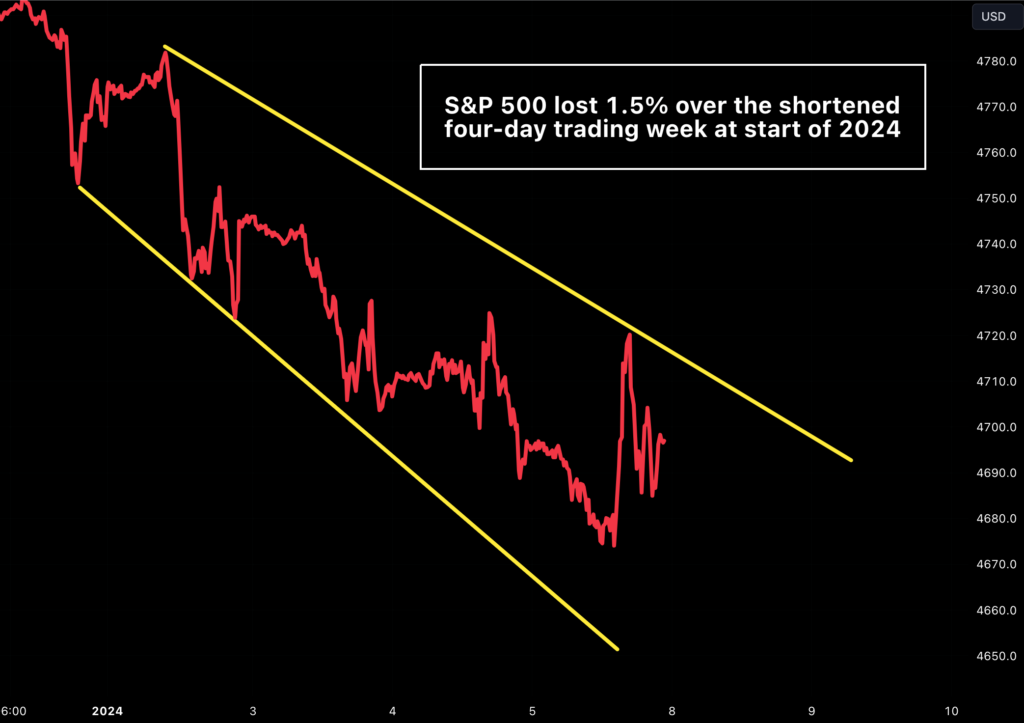The S&P 500 managed a modest uptick, but the cessation of a nine-week winning streak across major indices painted a broader picture of investor uncertainty. This shift in sentiment comes in the wake of a stronger-than-expected jobs report, challenging expectations of imminent Federal Reserve rate cuts. The Nasdaq Composite and the Dow Jones Industrial Average mirrored this hesitation, with the Nasdaq facing its worst weekly performance since September. Global markets echoed this uncertainty, with European stocks dipping and the Stoxx 600 index closing lower, weighed down by a surprising downturn in German retail sales. Concurrently, oil prices saw an uptick amid rising geopolitical tensions, while the Canadian Dollar experienced a volatile session after mixed labour market reports. As investors navigate through a complex array of economic data, from robust US job additions to unexpected shifts in euro zone inflation, the market narrative evolves into one of cautious anticipation, closely monitoring the interplay between economic health indicators and central bank policies.

Key Takeaways:
- End of a Winning Streak for Major Indices: The S&P 500 concluded Friday slightly higher at 4,697.24, gaining 0.18%, while the Nasdaq Composite inched up 0.09% to 14,524.07. The Dow Jones Industrial Average modestly rose by 25.77 points, or 0.07%, to settle at 37,466.11. However, all three indices snapped their nine-week winning streak, reflecting a shift in market sentiment.
- Nasdaq’s Worst Weekly Performance Since September: The Nasdaq suffered the most among the major indices, declining 3.25% over the week, its poorest performance since September. This was paralleled by the S&P 500 and Dow, which dropped 1.52% and 0.59%, respectively.
- Stronger-than-Expected Jobs Data Impacts Rate Cut Expectations: The U.S. economy outperformed expectations by adding 216,000 jobs in December, surpassing the Dow Jones estimate of 170,000. The unemployment rate held steady at 3.7%, intensifying speculation about the Federal Reserve’s interest rate policy.
- Euro Zone Inflation and German Retail Sales Impact European Markets: In Europe, the Stoxx 600 closed down 0.1% after German retail sales unexpectedly fell 2.5% month-on-month. Euro zone inflation climbed to an annual 2.9% in December, complicating the European Central Bank’s rate decision strategy.
- FAA Orders Grounding of Boeing 737 Max 9s: Following a serious mid-flight incident involving an Alaska Airlines plane, the FAA has grounded more than 170 Boeing 737 Max 9 aircrafts for inspection. Both Alaska and United Airlines have responded by grounding their entire Boeing 737 Max 9 fleets. This precautionary measure reflects heightened safety concerns in the aviation sector.
FX Today:
- Euro Struggles Amid Inflation Data; EUR/USD Dynamics in Focus: The Euro faced a challenging session, reacting to the latest inflation data that showed an uptick to 2.9% year-on-year in December, up from 2.4% in November. Despite this increase, the EUR/USD pair experienced volatile movements, initially dipping to a three-week low before rallying to near 1.0940. The pair started the day under pressure, dropping from the 1.1040 region, and then fluctuating significantly in response to the Eurozone and U.S. economic reports.
- British Pound Strengthens Against Dollar; Mortgage Rate Impact Watched: GBP/USD saw a rally in Q4, approaching the key 1.2765 Fibonacci threshold, the 61.8% retracement of the 2021/2022 selloff. A break above this level could bring the 200-week SMA and trendline resistance at 1.2900 into focus, potentially empowering buyers to target 1.3145 and 1.3500. If the momentum shifts, the pair might decline towards 1.2450, near the 50-week SMA, with potential to rebound or further drop to trendline support at 1.2340. This movement was buoyed by positive economic data and a recent decrease in UK mortgage rates. Further weakness could retest the October lows and possibly lead to 1.1800.
- Japanese Yen Weakened by U.S. Jobs Data; USD/JPY Nears Key Threshold: The USD/JPY pair faced resistance at the significant 152.00 level, the 2022 high, in Q4 but failed to break through. Despite its overall uptrend, a shift in bias could occur if it falls below the 50-week SMA at 141.00, potentially leading prices to 137.50 and then to a major Fibonacci level at 133.20. A breakdown might direct it towards trendline support around 130.00, and further down to 127.33, marking the 50% retracement of the Jan 2021/Oct 2022 rally. Conversely, a bullish scenario sees resistance at 145.30, and then 148.50. A breakthrough here could push the pair towards 2023’s peak, with the 158.00 level as a potential target.
- Canadian Dollar’s Volatile Day on Mixed Labor Market Reports: The Canadian Dollar experienced significant volatility, initially weakening against the US Dollar following the US NFP report and Canada’s labour market data, but later recovering. The USD/CAD pair saw a surge towards 1.3400 post-NFP, then a sharp reversal to 1.3290, before settling near 1.3360. The mixed data and ensuing market reaction highlight the sensitivity of the CAD to North American economic indicators.
- T-note Movements Suggest Market Reassessment: The U.S. Treasury notes moved lower, influenced by the stronger-than-expected U.S. December payrolls report. This led to a rise in the 10-year T-note yield to a 3-week high of 4.097%, suggesting a market reassessment of the Fed’s potential rate cut timeline.
- Oil Prices Rise Amid Middle East Tensions: The week witnessed a notable rise in oil prices, influenced by escalating tensions in the Middle East. West Texas Intermediate (WTI) climbed, ending the week at $73.81 per barrel, an increase of approximately 3%. Similarly, Brent crude saw a rise, settling at $78.76 per barrel, marking a gain of 2.23%. This upward trend in oil prices could have a significant impact on currency pairs associated with oil-exporting nations, potentially affecting market sentiment towards commodity-linked currencies.
Market Movers:
- Regional Banks Rally: Regional banking stocks witnessed notable growth, contributing to broader market gains. Synchrony Financial (SYF) and Zions Bancorp (ZION) closed up more than 3%. Other regional banks like Comerica (CMA), KeyCorp (KEY), and Huntington Bancshares (HBAN) also saw gains exceeding 2%.
- Constellation Brands Beats Expectations: Constellation Brands (STZ) reported a strong Q3 with comparable EPS of $3.19, surpassing the consensus estimate of $3.03. The stock closed up over 2% after the company also raised its full-year operating cash flow estimate to $2.6 billion-$2.8 billion, up from a previous estimate of $2.4 billion-$2.6 billion.
- Carnival Corporation Gains on Upgrade: Carnival (CCL) saw its stock price increase by over 2% after Wells Fargo Securities upgraded the stock to overweight from equal weight and set a price target of $22, reflecting renewed investor confidence in the travel and leisure sector.
- Elanco Animal Health Sees Bullish Upgrade: Elanco Animal Health (ELAN) stock surged more than 6% after receiving an upgrade to buy from hold by Stifel, with a new price target of $20.
- MSCI Inc Faces Downgrade Pressure: MSCI Inc (MSCI) led the losers in the S&P 500, falling more than 3% after Raymond James downgraded the stock to market perform from outperform.
- Managed Healthcare Stocks Under Pressure: Managed healthcare stocks faced downward trends, with Humana (HUM) and UnitedHealth Group (UNH) closing down more than 1%, leading the losers in the Dow Jones Industrials. Elevance Health (ELV) also closed down nearly 1%.
- Conagra Brands Adjusts to Price Target Cuts: Conagra Brands (CAG) saw its stock price decline more than 1% as analysts reduced their price targets on the stock by an average of 3.4% following its earnings report.
- Palantir Technologies Downgraded: Palantir Technologies (PLTR) saw its stock fall more than 1% after Jeffries downgraded the company to underperform from hold with a price target of $13.
Conclusion:
As we close the first week of the new year, the financial markets reflect a tapestry of complexities and recalibrations. The breaking of the major indices’ nine-week winning streak, contrasted against a backdrop of robust job additions in the U.S. and heightened euro zone inflation, underscores the intricate balance investors are navigating. The dichotomy of sector performances, from the buoyancy in airline and banking stocks to the technology sector’s struggles and managed healthcare’s downturn, illustrates the nuanced nature of market dynamics. The fluctuating currency values, oil prices responding to geopolitical tensions, and varying reactions to corporate news further paint a picture of an evolving economic landscape. Investors, now more than ever, are required to weigh a multitude of factors – from central bank policies to global economic health indicators – in their decision-making processes.














